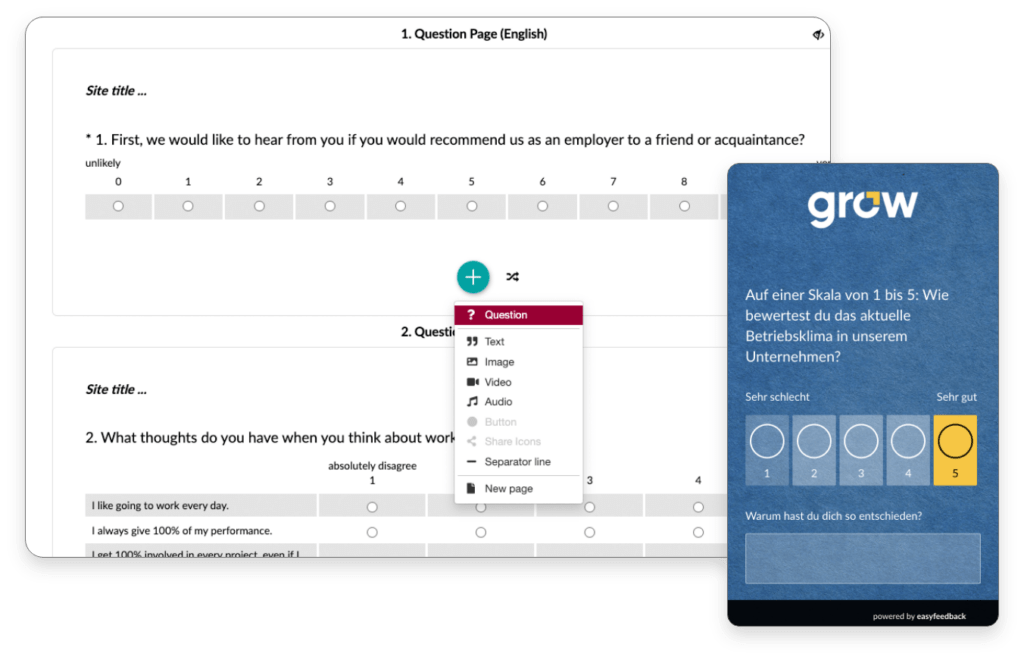Create your own employee survey


Solutions / Employee Survey / Create your own employee survey
Creating an employee survey is not difficult.
In the following steps, we will show you how to design and set up an employee survey tailored to your company, invite your colleagues and evaluate the results.
Step 1: Define objectives and survey group

The objective of the employee survey always comes first – even before you start thinking about or selecting questions.
Always define the objective first:
- Why do you need the feedback and what do you want to achieve with it?
By answering the questions, you can define the objective of the employee survey.
Once you have defined the objective, the survey group is also derived from this:
- Does it make sense to survey the entire workforce, or does the employee survey only affect some of your colleagues?
Why is this important?
The selection of the survey group determines how you later invite people to take part in the survey.
2. Design of the questionnaire
As soon as the objective(s) are known, start designing the questionnaire.
The main thing here is to select the right questions.
If the aim of the survey is to improve the working atmosphere, then you should ask about general employee satisfaction, internal communication between colleagues and with superiors, as well as workplace stress.
If your goal is to optimize internal processes, then you should select questions about your processes and give employees the opportunity to make suggestions for improvement (free text answers).

Tip:
When formulating the questions, start from the back.
This means: First think about what statement you want to make with the results.
The question formulation and the question type are derived from this.
Example: You have the feeling that some colleagues do not like working together and that this makes communication more difficult or that important information does not always reach them, resulting in additional work.
At the end of the employee survey, you would therefore like to know in which department communication between colleagues needs to be improved.
Your statement should therefore be presented as follows when interpreting the results:
- “In department/team XY, 58 % of colleagues are not satisfied with communication between colleagues.”
This leads to the following question:
- “How satisfied are you with the communication in your team with your direct colleagues?”
And to obtain a percentage value as a statement, a matrix question (scale of 5: dissatisfied to very satisfied), a slider (0-100) or a closed question with 5 answer options is suitable.
You can design your individual questionnaire according to this scheme when you create your employee survey.
3. Structure of the questionnaire
After the conception, the employee survey is created.
To do this, log in to easyfeedback or create an account if you do not already have one.
To create the employee survey, you can start with a blank survey or use one of our templates.
If you start with a blank survey, you can transfer question by question from the concept to the questionnaire.
If you start with a template, you can also transfer your questions from the concept, but you will also receive our questions and can use these as a guide or adopt them.

4. Corporate design: logo, colors & font
In addition to the content of the questionnaire, the look and feel of your employee survey is also important.
If you present yourself visually as the sender of the survey, this increases confidence in the survey.
The survey does not come from “somewhere”, but from you as an employer.
To transfer the corporate design to the survey, simply open the layout configurator in easyfeedback and transfer your corporate design to the survey: upload logo, set background image & define company colors and fonts.
This will increase confidence in the survey and improve the quality of the responses.
5. Invite employees to the survey
As soon as you have set up and tested the questionnaire and the corporate design, the next step is to invite the employees.
The defined survey group now determines how you invite employees to the employee survey.
If all employees to be invited have an internal e-mail address, you can invite them via the easyfeedback e-mail invitation tool.
If only part of the survey group has an e-mail address, then a hybrid invitation to the employee survey is recommended: send one part by e-mail and provide one or more computers separately for the other part of the colleagues, e.g. production employees, where they can take part in the survey.
Or if they are allowed to scan the survey link via a QR code on their own smartphone and take part.
It is also possible to place the survey link on the intranet.
To prevent multiple participation, you could work with unique access codes. This means that everyone can only take part once and the results cannot be falsified.

6. Monitor participation
Once the invitations have been sent out, you will very quickly see the first participants.
As a rule, employees take part in the survey directly on the same day or the day after.
These two days have the highest participation rate.
After that, the participation rate will fall as the majority of the workforce has already taken part.
After approx. 7 days, you can send a reminder about the survey to remind the remaining employees to take part.
7. Analyze results
At the end of the survey comes the most exciting part: the results analysis.
You have already viewed the results during the survey and waited for all employees to give their feedback.

You should proceed as follows when analyzing the results:
First, look at the overall result: Question by question as well as the free text answers.
Then start to segment the overall result and look at individual subgroups.
For example, the feedback from a department or work group.
This allows you to assign the feedback more specifically.
Segmentation is carried out by filtering the result using the result filters.
The criterion for segmentation is always different.
It depends on the objective and the survey group.
For example, if you are conducting a full survey among employees, the department or location can be a filter criterion.
If you are only conducting a partial survey, the filter criterion can be a project name.
Just remember that the filter criterion must be asked as a question or you must enter the required information in the participant list beforehand.
8. Derive recommendations for action
By analyzing the results, you gain insight into the responses at an overall or partial level.
However, the aim of the survey is to derive recommendations for action at the end so that improvements can be made.
You derive the recommendations for action by noting the negative points per question or question topic and deriving countermeasures/improvements from them.
Depending on the scope of the survey, there may be many points. Don’t let this put you off.
First collect all the points.
Then sort the individual points and merge them if necessary.
Next, make a list of all the points and put the measures where you can bring about change most quickly at the top.
By implementing the first points quickly, you can make an immediate improvement and show your employees that participating in the survey has a positive effect and that something is changing as a result.
Further information


